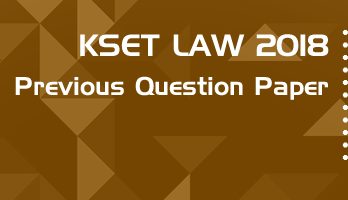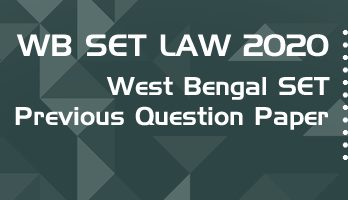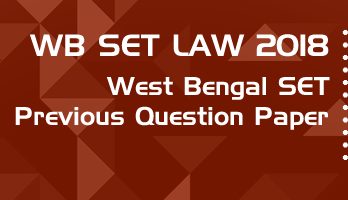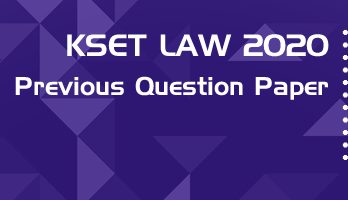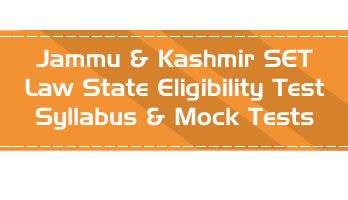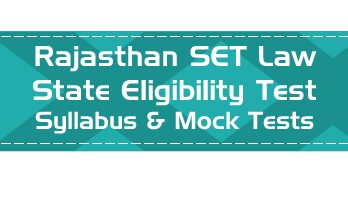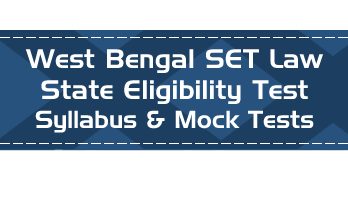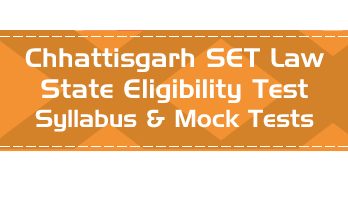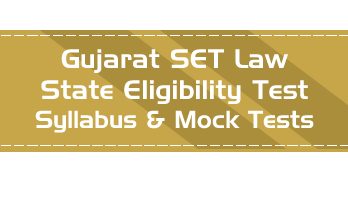- Based on latest Telangana State Eligibility Test Law Paper II Syllabus
- Law Subjects Overview Material covering important topics and concepts - 650 page PDF Book
- 50 Full Length Mock Tests - New Pattern Paper II, with 100 questions each
- 50 Mini Practice Mock tests - with 25 questions each
- Unlimited Practice - New Questions in every mock test with every attempt
- Answer choices of all questions shuffled randomly for better practice
- Database of over 9500 MCQs covering the entire syllabus
- Includes new comprehension based questions
- Questions & Answer Choices randomly shuffled in every attempt for better practice
- Accessible 24 x 7 via Smart-Phone browsers and Desktops
"Just wanted to let you know that I have cleared JRF with 99.99th percentile. Thank you for all your help and support that made it possible. " - Kanchan Yadav
"Thank you so much for the UGC NET test series. I finally qualified the exam. It was possible because of the mock test series provided by your team." - Robin Jaiswal
This previous question paper is Law Paper III from the TS SET law 2013 – Telangana State Eligibility Test that was conducted in 2013.
The pattern of the TS SET Law has been changed from 2018 onward, where the previous paper III has been removed and the scope of Paper II has been increased from 50 questions to 100 questions. Which means that the current paper II will have questions from the complete official syllabus.
The questions from this paper are included in the database for the TS SET Law Online Mock tests, Sample papers and MCQ Practice pack.
Check out the latest official syllabus and details of the TS SET Law in this article : TS SET Law Syllabus and Details.
Note : The syllabus for the UGC NET papers 1 & 2 has been changed since Jan 2019; so the syllabus for this exam is also expect to change.
TS SET Law Previous Question Paper III 2013
1. Match the item from List I with an item with List II and choose the correct answer from code :
List – I
I. Fundamental Rights
II. Directive Principles
III. Fundamental Duties
IV. Parliamentary
List – II
1. Britain Constitution
2. Constitutions of of State Policy Socialist Countries
3. American Constitution
4. Irish Constitution Democracy
Code : I II III IV
(A) 3 4 1 2
(B) 1 2 3 4
(C) 3 4 2 1
(D) 2 3 1 4
2. In case of a conflict between a State Law and Union Law with respect to a subject enumerated in concurrent list which law prevail over which ?
(A) State law shall prevail over Union Law
(B) Union law shall prevail if it is made subsequent to State law
(C) Union law will prevail whether it is passed before or after the law made by the State Legislature
(D) Union law will prevail if it is made prior to the law made by the State Legislature
3. Passive smoking will have impact on the health of public and hence public smoking is banned. This Supreme Court observation is in the case of
(A) Mandal case
(B) Murali S. Deora case
(C) Maneka Gandhi case
(D) Manu Bhai Sha case
4. Protection of lakes is an objective expressly stated in which one of the following ?
(A) Fundamental Duties
(B) Directive Principles of State Policy
(C) Fundamental Rights
(D) Eleventh Schedule to the Constitution
5. I. R. Coelho V. State of Tamil Nadu refers to
(A) Executive action taken in the name of the Governor is the executive action of the State
(B) Constitutional validity of laws included in the Ninth Schedule
(C) Colourable re-promulgation of ordinance is unconstitutional
(D) Reservation in unaided private colleges
6. Money Bill can be introduced in
(A) Lok Sabha only
(B) Rajya Sabha only
(C) Either of the Houses
(D) Joint Session of the Parliament
7. Choose the correct answer based on the statements – Assertion (A) and Reason (R)
Assertion (A) : In Minerva Mills V. Union of India Art. 31-C as amended by the 42nd Amendment Act, 1976 was held invalid.
Reason (R) : The amendment of Art. 31-C destroyed the basic structure of the Constitution.
Code :
(A) (A) is correct, but (R) is wrong
(B) Both (A) and (R) are correct
(C) (A) is wrong, but (R) is correct
(D) Both (A) and (R) are wrong
8. The present Election Commission of India consists of
(A) Chief Election Commissioner and two Election Commissioners
(B) Chief Election Commissioner only
(C) Chief Election Commissioner and one Election Commissioner
(D) Three Election Commissioners
9. Constitutional law describes various organs of the government in rest while administrative law describes them in motion.
(A) Dicey
(B) Holland
(C) Jennings
(D) Maitland
10. Famous case decided by Privy Council regarding constitutionality of rule making
(A) In re Delhi laws case
(B) Hamdard Dawakhana case
(C) R Vs Burah
(D) In re Kerala Education Bill
11. Who has championed the cause of introducing Jan Lokpal Bill in India ?
(A) Sunderlal Bahuguna
(B) Santosh Hegde
(C) Anna Hazare
(D) Medha Patkar
12. X whose latest book is not included in the list of reference books by Y who has been authorised to select appropriate books for the concerned subject. Which writ can be issued against him ?
(A) Prohibition
(B) Quo warranto
(C) Mandamus
(D) None of the above
13. Read the following passage and answer the question : It is explicitly clear that doctrine of natural justice requires supply of a copy of inquiry officer’s report to the delinquent if the enquiry officer is other than the disciplinary authority. It is also clear that non-supply of the report of inquiry officer is in breach of natural justice. But it is equally clear that failure to supply report of the enquiry officer to the delinquent employee would not ipso facto result in proceedings being declared null and void and order of punishment non est and ineffective. It is for the delinquent employee to plead and prove that nonsupply of such report has caused prejudice and resulted in mis-carriage of justice. If he is unable to satisfy the court on that point, the order of punishment cannot automatically set aside. By reading the above paragraph draw the correct conclusion from the following :
In case the enquiry officer is a disciplinary authority
(A) The supply of copy of inquiry officer’s report is necessary
(B) The supply of copy of inquiry officer’s report is not necessary
(C) The supply of copy of the disciplinary authority sometimes is necessary
(D) None of the above
14. Read the following passage and answer the question : It is explicitly clear that doctrine of natural justice requires supply of a copy of inquiry officer’s report to the delinquent if the enquiry officer is other than the disciplinary authority. It is also clear that non-supply of the report of inquiry officer is in breach of natural justice. But it is equally clear that failure to supply report of the enquiry officer to the delinquent employee would not ipso facto result in proceedings being declared null and void and order of punishment non est and ineffective. It is for the delinquent employee to plead and prove that nonsupply of such report has caused prejudice and resulted in mis-carriage of justice. If he is unable to satisfy the court on that point, the order of punishment cannot automatically set aside. By reading the above paragraph draw the correct conclusion from the following :
As a general rule, punishing without supplying the enquiry officer’s report to the delinquent employee
(A) Results in proceedings being null and void and the order of punishment is ineffective
(B) Results in proceedings need not be void and the order of punishment is effective
(C) In exceptional cases only the proceedings are void and the order of punishment will not be effective
(D) All the above
15. Read the following passage and answer the question : It is explicitly clear that doctrine of natural justice requires supply of a copy of inquiry officer’s report to the delinquent if the enquiry officer is other than the disciplinary authority. It is also clear that non-supply of the report of inquiry officer is in breach of natural justice. But it is equally clear that failure to supply report of the enquiry officer to the delinquent employee would not ipso facto result in proceedings being declared null and void and order of punishment non est and ineffective. It is for the delinquent employee to plead and prove that nonsupply of such report has caused prejudice and resulted in mis-carriage of justice. If he is unable to satisfy the court on that point, the order of punishment cannot automatically set aside. By reading the above paragraph draw the correct conclusion from the following :
The burden of proof to prove that nonsupply of such report has caused prejudice and resulted in miscarriage of justice is on
(A) Enquiry officer
(B) Delinquent employee
(C) Both enquiry officer and delinquent employee
(D) None of the above
16. Read the following passage and answer the question : It is explicitly clear that doctrine of natural justice requires supply of a copy of inquiry officer’s report to the delinquent if the enquiry officer is other than the disciplinary authority. It is also clear that non-supply of the report of inquiry officer is in breach of natural justice. But it is equally clear that failure to supply report of the enquiry officer to the delinquent employee would not ipso facto result in proceedings being declared null and void and order of punishment non est and ineffective. It is for the delinquent employee to plead and prove that nonsupply of such report has caused prejudice and resulted in mis-carriage of justice. If he is unable to satisfy the court on that point, the order of punishment cannot automatically set aside. By reading the above paragraph draw the correct conclusion from the following :
If the employee is unable to satisfy the Court that non supply of such enquiry officer’s report has caused prejudice and resulted in miscarriage of justice
(A) Court must set aside the order of punishment automatically
(B) Court cannot set aside the order of punishment automatically
(C) Court must not set aside the punishment automatically
(D) None of the above
17. Salmond enumerates five characteristics of legal rights. Four such characteristics are
1. Subject of right
2. Object of right
3. Content of right
4. Title of right, and the fifth characteristic is :
(A) Property in respect of which right is claimed
(B) Act of omission required by the right
(C) The legal reason for the existence of the rights
(D) The subject of the corresponding duty
18. Ratio decidendi means
(A) The whole of the judgment
(B) The reasoning of the judgment
(C) Irrelevant part of the judgment
(D) Facts of the case
19. Examine the statements Assertion (A) and Reason (R) carefully and select the answer using the code given below
Assertion (A) : Precedent is like gold in a mine.
Reason (R) : It has to be searched in law reports.
Code :
(A) (A) is correct, but (R) is wrong
(B) Both (A) and (R) are correct
(C) (A) is wrong, but (R) is correct
(D) Both (A) and (R) are wrong
20. Which of the following is the correlative of immunity ?
(A) No-right
(B) Duty
(C) Disability
(D) Subjection
21. An idol of Lord Krishna in a temple is
(A) a natural person
(B) a legal person
(C) not a person in the eye of law because only the priest of the temple will be a person
(D) not a person because no personality can be conferred on God
22. Match the following :
List – I Name of the Case
I. Shabanoo Case
II. M.C. Mehta Case
III. Rudal Shah Case
IV. Randhir Singh Case
List – II Judicial Contribution
1. Right to Compensation
2. Right to Maintenance
3. Right to Equality
4. Right to Environment
Code : I II III IV
(A) 2 4 1 3
(B) 2 1 3 4
(C) 3 1 2 4
(D) 3 2 4 1
23. Which one of the following statements correctly conveys Fuller’s theory of inner morality of law ?
(A) Every piece of law in order to be valid, must fulfil certain procedural requirements like generality, prospectivity promulgation, intelligibility and consistency
(B) The contents of every law in order to be valid must be of a minimum moral standard
(C) The question of morality of every law is a matter for the inner conscience of the legislators and judges have nothing to do with it
(D) The question of morality of law is not for the courts to determine
24. Which of the following is/are inchoate crime ?
1) Attempt to commit a crime
2) Criminal conspiracy
3) Theft
4) Murder
Select the correct answer using the code given below :
(A) 1 and 4
(B) 1, 2 and 3
(C) 1 and 2
(D) 2 only
25. Which one of the following is not an element of Theft ?
(A) Dishonest intention to take movable property
(B) Moving of movable property with dishonest intention to take it out of the possession of another person
(C) Dishonest inducement to deliver movable property
(D) Moving of movable property in order to accomplish the taking of it without the consent of the possessor
- Based on latest Telangana State Eligibility Test Law Paper II Syllabus
- Law Subjects Overview Material covering important topics and concepts - 650 page PDF Book
- 50 Full Length Mock Tests - New Pattern Paper II, with 100 questions each
- 50 Mini Practice Mock tests - with 25 questions each
- Unlimited Practice - New Questions in every mock test with every attempt
- Answer choices of all questions shuffled randomly for better practice
- Database of over 9500 MCQs covering the entire syllabus
- Includes new comprehension based questions
- Questions & Answer Choices randomly shuffled in every attempt for better practice
- Accessible 24 x 7 via Smart-Phone browsers and Desktops
"Just wanted to let you know that I have cleared JRF with 99.99th percentile. Thank you for all your help and support that made it possible. " - Kanchan Yadav
"Thank you so much for the UGC NET test series. I finally qualified the exam. It was possible because of the mock test series provided by your team." - Robin Jaiswal


